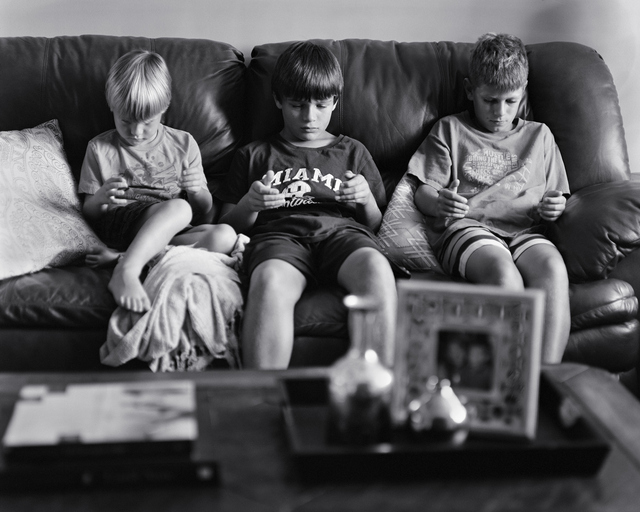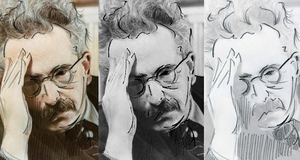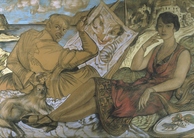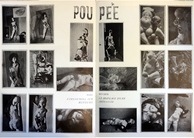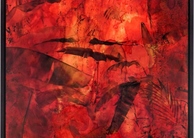The Loneliness of Digital Devices: Examining "Removed" (Photo Series) by Eric Pickersgill
By
2016, Vol. 8 No. 03 | pg. 1/2 | »
IN THIS ARTICLE
KEYWORDS
The 2015 photo series “Removed,” shot by Eric Pickersgill, contains twenty-eight black and white photographs showing different individuals of all ages staged in various settings looking down at their palms as if scrolling through their cellphones. However, each photograph is missing a key aspect: the cellphone. Inspired by the now all-too-common distracted family, sitting together in a restaurant but captivated by their devices, Pickersgill addresses technology users around the world and makes a bold statement as to the lonely, disjointed lives people face when engrossed in their digital screens. Selected Photos from Removed by Eric Pickersgill Photographs © Eric Pickersgill Pickersgill portrays cellphones in a negative light, making his photo series black and white to not only emphasize his subjects’ faces and body positions, but also to highlight the sharp contrast between traditional photographs taken during particular instances like family dinners or wedding days and Pickersgill’s perception of such occurrences. Furthermore, the black and white accentuates the disconnection and lack of communication between the subjects by creating a depressing and almost eerie feeling of silence around his photographs. Even though his photographs are staged, this aspect only emphasized Pickersgill’s point because the lack of personal interaction between individuals is almost comedic and unreal. The lack of personal interaction between Sherry Turkle discusses ideas on a similar theme in her book Alone Together: Why We Expect More from Technology and Less from Each Other (2012). In this informative work, Turkle examines the consequences of excessive technology use in the United States on people’s social interactions and relationships through dozens of interviews, specifically highlighting the effects on families, friends, and couples. Through her observations, Turkle found that “we [people] defend connectivity as a way to be close, even as we effectively hide from each other” (Turkle, 251). She shows that the growing reliance on technology, which aims to connect and bond individuals around the world, instead creates moments of disjunction and being “alone together” in social settings. In these cases, people are physically together in a home, restaurant, or building, but avoid intimate conversation and interaction because they are mentally in different electronic worlds, thousands of pixels away from one another. This disconnectedness arises primarily because when using technology, individuals are usually multitasking and appear to be in “cruise control,” (Turkle, 240) where their attention is focused on something else. In a similar vein, Pickersgill's photographs represents cellphone usage in the United States as a detrimental and toxic form of communication. By removing cellphones from his subjects’ hands in each of his photographs, Pickersgill focuses his viewers attention on the subjects’ faces, specifically on their staring, downcast eyes, bowed heads, and hypnotized looks, making the audience realize that cellphone usage creates tendencies of being “alone together.” Users’ inclinations toward being in “cruise control” when using their device establish sentiments full of isolation and lack of emotion in everyday relationships with other people. Our Growing ObsessionPickersgill's message is undergirded by the sheer number of Americans who use cellphones on a regular basis. According to the Mobile Technology Fact Sheet created by the Pew Research Center, roughly 64% percent of Americans owned smartphones as of 2014, and 90% own a cellphone. Moreover, 29% percent of these individuals believe that their cellphone is “something they can’t imagine living without,” while "67% of cell owners find themselves checking their phone for messages, alerts, or calls — even when they don’t notice their phone ringing or vibrating." This growing dependency on smartphones attracts the attention of clinical psychiatrists like Dane Archer, who describes the changing norms and beliefs that originated since the evolvement of a condition he calls “nomophobia.” According to Archer, “nomophobia,” or the fear of being separated from the cellphone, is a growing concern in the United States as cellphone addiction becomes more prominent in daily life. Addicts oftentimes feel anxiety, constantly check their phone for updates, and experience phantom cellphone vibration syndrome. What is more concerning, however, is that these individuals utilize their devices in not only public situations like with friends or family at movie theaters and restaurants, but also in personal times like using the bathroom, shower, or even having sex with their significant other. Nomophobia: the fear of being separated from your cellphone.
The slow increase of cellphone addiction in America has created evolving norms throughout society. Sit-down family dinners are becoming much less frequent in many households and some restaurants and other businesses are enforcing “no cellphone” policies to prevent disturbances. The changing standards in modern society can be seen in Eric Pickersgill’s images as individuals separate themselves from others, both willingly and unintentionally, to feel more sociable and connected. As people move through their lives and participate in major milestones, the cellphone constantly has a presence. Analyzing Pickersgill's PhotographsIndividualsIn his photo series, Pickersgill emphasizes the effects that technology has on individuals in their younger years, especially during the time before they find love, get married, and have children. In these images in particular, Pickersgill creates anomalies for the rest of his photo series because these photographs hide the subjects’ faces, instead showing their hair and body language. As a result, these individuals seem strangely outcast, even in the company of other people. According to Sherry Turkle, adults and teenagers of all ages utilize the Internet and their technologic devices in order to appear happy and “authentic” (Turkle, 131) in their every day lives. To do this, people use their phones to post photographs, tweets, and updates showing their followers numerous activities that they participate in, even though they may not be things they do ordinarily. In a way, the Internet allows people to create an alternate, online persona for themselves. As a result, many people find themselves “feeling let down when they move from the virtual world to the real world” (Turkle, 22). This is because a line forms between the online world and reality, making it difficult to differentiate between real and fake. In the real world, many individuals feel as though they are unable to achieve the same cheerful and problem-free state that their friends give off in their online profiles. As a result, they find themselves alone, separated, and unable to connect with other people. In the first photo (above), a woman is depicted taking a photograph of a couple in a park. The woman faces away from Pickersgill’s camera and holds up a cellphone in her hand. However, as part of the photo series’ theme, Pickersgill removes the cellphone from the photograph, so her hand appears clenched in front of her. Meanwhile, on the other side of the camera, the couple poses while embracing one another. While this image recreates countless everyday situations in which strangers and friends ask others to take their photograph, it also manages to evoke cruel, mysterious, and gloomy emotions as the sharp divide between fake reality and the real world is elucidated. The couple in the image symbolizes the fictitious side of technology in which individuals create modeled situations to represent themselves as flawless to their friends and followers. The couple smiles for the photograph, thus appearing happy, carefree, and as though they have no problems in the world. As a result, even though they may be experiencing issues in their relationship, the photograph hides these flaws. The image that woman photographer takes will portray the couple as whole and blissful, as if they are a stereotypical, “picture perfect” couple only seen in movies and fairytales. On the other side of the camera, the woman represents the real, authentic world where creating a fake persona is not so easy. Pickersgill takes the photo from an angle so that viewers cannot see her face, making them feel wonder and mystery toward the woman, curious about her emotions and identity. One can imagine that the happy couple plasters their images all over the Internet, while the woman feels like a failure because she is not as happy as they are. Her curled hand, which takes on an unnatural and even sinister form, gives viewers an idea of the sadness and isolation she feels from her seemingly fascinating and successful friends. CouplesThrough his black and white photographs, Pickersgill portrays couples as especially vulnerable to the effects of cellphone technology, even from day one: their wedding day. In Turkle’s opinion, people are naturally fearful of intimacy, especially in regards to relationships and feelings for another person, yet they do not want to be alone. Due to this fear of rejection or heartbreak, people use their cellular devices while physically with their significant other because “people disappoint, while robots [like cellphones] do not” (Turkle, 20). With the cellphone, individuals feel the comfort from the illusion of having a “community” that cares about them, yet they can hide certain facts or feelings to avoid full disclosure. As a result, the “networked life allows us to hide from each other, even as we are tethered to each other” (Turkle, 20). In the second photograph, a couple on their wedding day sits on the hood of their Mazda while looking down at the missing cellphones. The couple celebrates a very intimate day in their lifetimes, yet Pickersgill’s image exposes an unusual twist to a traditional wedding day photograph. Because a wedding is said to be the happiest day of couples’ lives, the newlyweds should be full of love, laughter, and smiles. But unlike the typical close and affectionate characteristics viewers expect to see from wedding photos, Pickersgill’s image possesses haunting and isolated features. Rather than hugging, touching, and kissing, the couple faces slightly away from each other on opposite ends of the vehicle they are sitting on. The “Just Married” banner in the car’s windshield looks like it is falling, as though symbolizing the couple’s already deteriorating and forgotten intimacy. Through this image, Pickersgill points out that because of the newly created closeness that comes with the bond of marriage, personal difficulties rise to the surface because as Turkle points out, “if you share something intimate… you invest in that person’s opinion,” (212). People naturally fear judgment and desire fitting in and being accepted, thus during revealing moments in time like wedding days, people dread vulnerability and rejection from other people. Consequently, they look toward technology to shelter them, acting as a barrier to prevent full vulnerability, even to individuals that share their experiences on a daily basis like a spouse. Though cellphone use can act as a security blanket for individuals fearful of weakness before their significant other, according to Winch electronic devices have detrimental effects on relationships. Specifically, the interference of technology in relationships, a term scientists coined “technoference,” creates large amounts of fighting and lowers couples’ happiness levels. Moreover, because using a cellphone when spending time with a significant other can feel like rejection, partners may experience depression and other mental illnesses in the long term. Exemplifying this situation, the third photograph depicts a woman sitting on the couch with her husband, as she stares down at the cellphone in her hand and he leans on her and also looks down at the device. At first glance, it appears to be an ordinary event of a married couple relaxing and spending time together in the living room. The couple appears to be cuddling on the couch while they look at an image on the cellphone. However, after taking a closer look, the couple does not appear connected to each other at all. Instead, viewers can see the pain, disappointment, and rejection on the husband's face as his spouse focuses on her smartphone rather than the man she married. Sitting upright, the wife appears to be leaning away from Louis rather than touching him, which makes it seem as though she feels more affection toward the cellphone that she cradles close to her body. On the other hand, her husband lies across the couch, placing his body as close to his wife as possible, as though asking for her to acknowledge his presence. Because his wife is mesmerized by her cellphone and is not paying attention to him, he inevitably feels outcast and rejected in their relationship. Pickersgill’s capture of the husband’s downturned lips, sad, droopy eyes, and overall limp body emphasizes the disappointment and dismissal he feels because of his wife’s decision to focus on technology instead of participating in meaningful conversation with him. In the image, she appears oblivious to her husband’s discontent, wearing an overall neutral and unconcerned expression. All in all, the photograph demonstrates the sharp contrast between the relationship of a stereotypical loving, happily married couple and the cold, isolated relationship of a couple deeply involved in technology. Pickersgill’s Removed series exemplifies that even on the wedding day, couples already appear detached and secluded from one another as a result of their electronic devices. As time goes on, with the emergence of new technology, romantic relationships become more difficult to maintain. Thus couples become more inclined to ignore one another, instead relying on their cellphones and experiencing Turkle’s concept of “alone together.” As these couples have children, however, the lack of connection between parents and technological usage has a similarly devastating impact on their offspring.Continued on Next Page » Suggested Reading from Inquiries Journal
Inquiries Journal provides undergraduate and graduate students around the world a platform for the wide dissemination of academic work over a range of core disciplines. Representing the work of students from hundreds of institutions around the globe, Inquiries Journal's large database of academic articles is completely free. Learn more | Blog | Submit Latest in Visual Arts |






